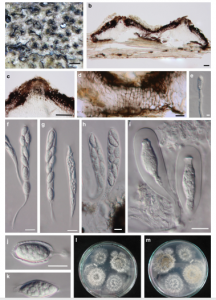Neodeightonia subglobosa C. Booth, in Punithalingam, Mycol. Pap. 119: 19 (1970) [1969].
Index Fungorum Number : IF318601; Facesoffungi number: FoF 01966;
Synonymy: See index Fungorum
Saprobic on dead bamboo culms. Sexual morphs: Ascostromata 160–220 μm high, 250–370 μm diam., immersed under epidermis to erumpent, gregarious, visible as minute black dots or papilla on host tissue, dark brown to black, uniloculate, globose to subglobose, coriaceous, with a centrally located ostiole, papillate. Peridium 17–40 μm wide, comprising several layers, with outer layers composed of relatively thick brown to black-walled cells of textura angularis, inner layers composed of light brown to hyaline cells of textura angularis, poorly developed at the base. Hamathecium of hyaline, septate, up to 2–4 μm wide pseudoparaphyses. Asci 110–150 × 16–20 μm (x = 124.8 × 19.5 μm, n = 20), 8–spored, bitunicate, fissitunicate, cylindro-clavate, pedicellate, apically rounded with well developed ocular chamber. Ascospores 17–21 × 8–10.5 μm (x = 20.5 × 8.4 μm, n = 20), 2–3-seriate, hyaline, aseptate, obovoid, usually wider at the apex, thick-walled, surrounded by a distinctive structured mucilaginous sheath. Asexual morph: Fertile on pine needls on WA after 1 month. Conidiomata 150–200 μm diam., pycnidial, immersed to superficial, solitary to gregarious, globose to subglobose, black, coriaceous. Conidiogenous cells 5–12.5 × 2–3 μm (x = 9.8 × 2.6 μm, n = 20), holoblastic, cylindrical, hyaline, straight to curved, smooth-walled. Conidia 11–13.5 × 8–10.5 μm (x = 12.6 × 9.3 μm, n = 20), globose to subglobose, hyaline, aseptate, smooth-walled, guttulate.
Culture characters: Ascospores germinating on PDA within 24 h and germ tubes produced from apex. Colonies growing fast on PDA, reaching 5 cm in 1 week at 28 °C, under 12 h light/12 h dark, effuse, velvety to hairy, circular, white in first week, dark brown to black after 1 week from below and above.
Material examined: THAILAND, Chiang Rai, Mae Fah Luang University, on dead culms of bamboo, 1 August 2011, Dong-Qin Dai DDQ00087 (MFLU 15–1189, reference specimen designated here); ibid. (KUN, HKAS88699, duplicates of reference specimen), living culture, MFLUCC 11– 0482, MFLUCC 11–0607; asexual morph, 19 June 2011, Dong-Qin Dai DDQ00041, living cultures, MFLUCC 11– 0388.
Notes: Neodeightonia subglobosa was originally collected from Bambusa arundinacea Willd. (synonym of Bambusa bambos (L. ) Vo s s ) in Africa, and int roduced by Punithalingam (1969). Phillips et al. (2008) isolated this species, which causes keratomycosis of the eye, from a human host in an unknown location, illustrated only the asexual morph, and provided a sequence based on the culture CBS 448.91. Phillips et al. (2013) however, indicated CBS 448.91 as ex-type without any justification. Liu et al. (2012a) illustrated the sexual morph of this species based on a new collection. In this study, new isolates and specimens were obtained collected on bamboo in Thailand with both sexual and asexual morphs. Thus a reference specimen is designated here, and these species is re-described and illustrated species, due to no available strain linked to Punithalingam (1969). Punithalingam (1969) stated that N. subglobosa has brown and 1-septate ascospores.
FIG Neodeightonia subglobosa (MFLU 15–1189, reference specimen). a Appearance of ascomata on bamboo. b Vertical section of ascoma. c Ostiole of ascoma. d Peridium. e Germinating ascospores. f–g Asci. i Immature asci. j, k Ascospores. l, m Culture on PDA. Scale bars: a = 200 μm, b, c = 50 μm, d–k = 10 μm

